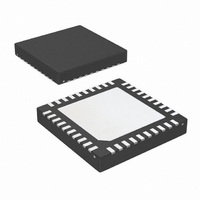LP3971SQ-2G16/NOPB National Semiconductor, LP3971SQ-2G16/NOPB Datasheet - Page 20

LP3971SQ-2G16/NOPB
Manufacturer Part Number
LP3971SQ-2G16/NOPB
Description
IC PMU FOR APPL PROCESSORS 40LLP
Manufacturer
National Semiconductor
Series
PowerWise®r
Datasheet
1.LP3971SQ-B510NOPB.pdf
(50 pages)
Specifications of LP3971SQ-2G16/NOPB
Applications
Processor
Current - Supply
60µA
Voltage - Supply
2.7 V ~ 5.5 V
Operating Temperature
-40°C ~ 85°C
Mounting Type
Surface Mount
Package / Case
40-LLP
Lead Free Status / RoHS Status
Lead free / RoHS Compliant
Other names
LP3971SQ-2G16
LP3971SQ-2G16
LP3971SQ-2G16TR
LP3971SQ-2G16
LP3971SQ-2G16TR
www.national.com
Buck Converter Operation
DEVICE INFORMATION
The LP3971 includes three high efficiency step down DC-DC
switching buck converters. Using a voltage mode architecture
with synchronous rectification, the buck converters have the
ability to deliver up to 1600 mA depending on the input volt-
age, output voltage, ambient temperature and the inductor
chosen.
There are three modes of operation depending on the current
required - PWM, PFM, and shutdown. The device operates in
PWM mode at load currents of approximately 100 mA or high-
er, having voltage tolerance of ±3% with 95% efficiency or
better. Lighter load currents cause the device to automatically
switch into PFM for reduced current consumption. Shutdown
mode turns off the device, offering the lowest current con-
sumption (I
Additional features include soft-start, under voltage protec-
tion, current overload protection, and thermal shutdown
protection.
The part uses an internal reference voltage of 0.5V. It is rec-
ommended to keep the part in shutdown until the input voltage
is 2.7V or higher.
CIRCUIT OPERATION
The buck converter operates as follows. During the first por-
tion of each switching cycle, the control block turns on the
internal PFET switch. This allows current to flow from the input
through the inductor to the output filter capacitor and load. The
inductor limits the current to a ramp with a slope of (V
V
During the second portion of each cycle, the controller turns
the PFET switch off, blocking current flow from the input, and
then turns the NFET synchronous rectifier on. The inductor
draws current from ground through the NFET to the output
filter capacitor and load, which ramps the inductor current
down with a slope of –V
The output filter stores charge when the inductor current is
high, and releases it when inductor current is low, smoothing
the voltage across the load.
The output voltage is regulated by modulating the PFET
switch on time to control the average current sent to the load.
The effect is identical to sending a duty-cycle modulated rect-
angular wave formed by the switch and synchronous rectifier
at the SW pin to a low-pass filter formed by the inductor and
output filter capacitor. The output voltage is equal to the av-
erage voltage at the SW pin.
PWM OPERATION
During PWM operation the converter operates as a voltage
mode controller with input voltage feed forward. This allows
the converter to achieve good load and line regulation. The
DC gain of the power stage is proportional to the input voltage.
To eliminate this dependence, feed forward inversely propor-
tional to the input voltage is introduced.
While in PWM (Pulse Width Modulation) mode, the output
voltage is regulated by switching at a constant frequency and
then modulating the energy per cycle to control power to the
load. At the beginning of each clock cycle the PFET switch is
turned on and the inductor current ramps up until the com-
parator trips and the control logic turns off the switch. The
current limit comparator can also turn off the switch in case
the current limit of the PFET is exceeded. Then the NFET
switch is turned on and the inductor current ramps down. The
OUT
)/L, by storing energy in a magnetic field.
Q, SHUTDOWN
= 0.01 µA typ).
OUT
/L.
IN
–
20
next cycle is initiated by the clock turning off the NFET and
turning on the PFET.
Internal Synchronous Rectification
While in PWM mode, the converters uses an internal NFET
as a synchronous rectifier to reduce rectifier forward voltage
drop and associated power loss. Synchronous rectification
provides a significant improvement in efficiency whenever the
output voltage is relatively low compared to the voltage drop
across an ordinary rectifier diode.
Current Limiting
A current limit feature allows the converters to protect itself
and external components during overload conditions. PWM
mode implements current limiting using an internal compara-
tor that trips at 2.0 A (typ). If the output is shorted to ground
the device enters a timed current limit mode where the NFET
is turned on for a longer duration until the inductor current falls
below a low threshold, ensuring inductor current has more
time to decay, thereby preventing runaway.
PFM OPERATION
At very light loads, the converter enters PFM mode and op-
erates with reduced switching frequency and supply current
to maintain high efficiency.
The part will automatically transition into PFM mode when ei-
ther of two conditions occurs for a duration of 32 or more clock
cycles:
A: The inductor current becomes discontinuous.
B: The peak PMOS switch current drops below the I
level, (Typically I
FIGURE 1. Typical PWM Operation
MODE
< 30 mA + V
IN
/42Ω).
20180711
MODE











